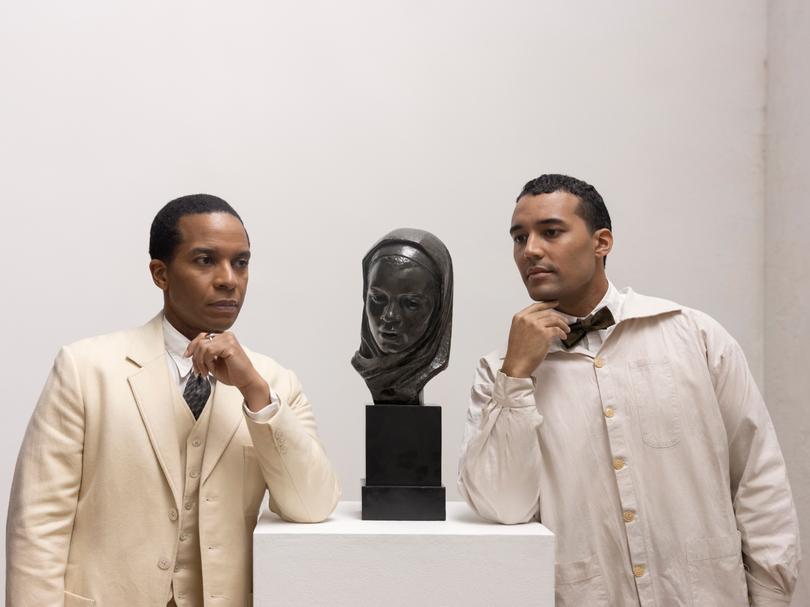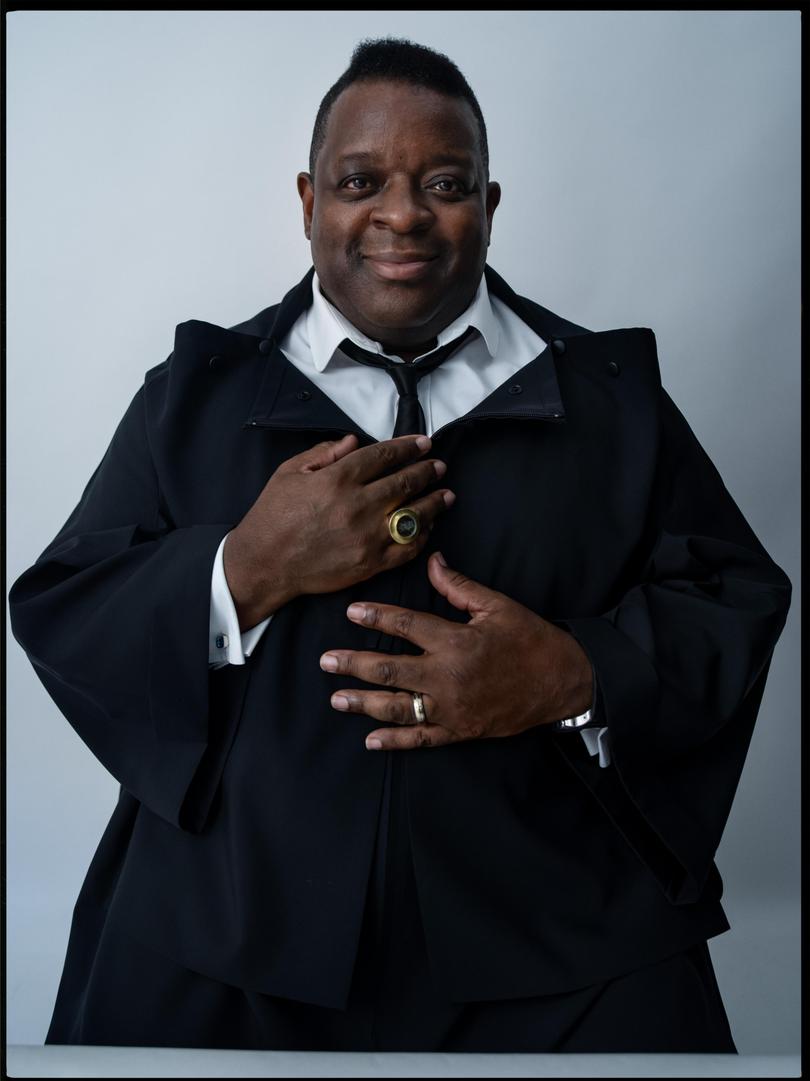JOHN McDONALD: Isaac Julien’s vision digs deep into the cultural attitudes on race in African art collections

Dr Albert C. Barnes was one of the greatest art collectors of the 20th century, and one of its most odious personalities. He made his fortune with eyewash — an antiseptic compound called Argyrol. Although he claimed to have invented this wondrous product, in reality he only marketed it. His career could serve as a premonition of that self-styled “genius” of our own era, Elon Musk, if the latter had ever shown an interest in art.
Barnes (1872-1951) was not merely a collector, he was a fanatic. Today, the Barnes Foundation of Philadelphia owns more than 4000 pieces, including 181 works by Renoir, 69 by Cézanne, 59 by Matisse, 46 by Picasso… you get the picture. There are Old Masters; furniture and decorative arts; Greek and Roman artefacts; ancient Egyptian, Native American, and African art.
It’s the African material that captured the attention of British artist, Isaac Julien, when he responded to a commission from the Barnes Foundation. Julien’s five-channel video installation, Once Again… (Statues Never Die) (2022) can be seen at Sydney’s Museum of Contemporary Art until February.
Sign up to The Nightly's newsletters.
Get the first look at the digital newspaper, curated daily stories and breaking headlines delivered to your inbox.
By continuing you agree to our Terms and Privacy Policy.In a career of four decades, Julien has become known for audiovisual works that inhabit the interstices between fine art and cinema. His unstoppable rise was celebrated last year with a retrospective at Tate Britain.
As Julien’s core themes have always been race and gender, he is the perfect artist for an art world infatuated with identity politics, but he has frequently sought to distance himself from his ideologically blinkered admirers. In the Tate catalogue, we learn that right from his student days, he was concerned not to be stereotyped as a “Black, queer filmmaker”, preferring to be called “a broader cultural activist”.
Nevetheless, he has been consistent in his choice of subjects — from Langston Hughes, the leading poet of the “Harlem Renaissance” of the 1930s, in Looking for Langston (1989), to freed slave and author, Frederick Douglass, in Lessons of the Hour (2019). In Once Again… (Statues Never Die), Julien finds a new protagonist in Alain Locke (1885-1954), a black American philosopher and sometime protégé of Dr Barnes.

Black, gay, highly intellectual, a collector of art, Locke (played by André Holland) might have been designed specifically for one of Julien’s films. For most viewers he will be a surprising discovery. In one scene, Locke discusses African art with Dr Barnes (Danny Huston), who speaks in a genial, patronising manner, making it clear he has time only for his own theories.
This conversation enables Julien to delve into the contemporary debate about the way museums should display and contextualise items made by tribal people. In the 1920s-30s many collectors believed that pieces by so-called “primitive” artists should be valued chiefly as inspirational objects for the great modernists. No matter how much one admired these artefacts, there was an unbridgeable gulf between savagery and civilisation.
Barnes, who thought of himself as the black man’s best friend, claimed that the spiritual power of these works was distilled from the collective sufferings of African people. Julien has him extolling “the revelation of the primitive statues of the black African race.”
Locke, a life-long dandy who was disdainful of black protest movements, was more precise, believing African sculptures needed to be appreciated on their own terms, for the originality of their forms and techniques. He tells Barnes this work shouldn’t be treated as “an exotic fad.” Locke was convinced that the way forward for blacks was to beat the white majority at their own game – to be exceptional artists, writers and thinkers in what we might call the European tradition. The African inheritance would make its own energising contribution to an emerging modern idiom.
While Barnes may have celebrated the spiritual superiority of black people, Locke apparently saw this as just another way of treating them as outsiders - a mysterious group, forever separated from the mainstream by virtue of their African roots.
It wasn’t just Locke who felt suspicious of Barnes’s extravagant sympathy for black Americans. The philosopher, Bertrand Russell, quipped that Barnes “could only get on with dogs and coloured people because he did not regard them as equals.”

When he went to war with local authorities because of a plan to build new houses in his wealthy suburb, Barnes threatened to transfer his collection to another city and turn the Foundation into a centre for the study of black culture. There goes the neighbourhood!
This tension between Barnes and Locke is one of the strands that runs through this fractured 40-minute narrative spread across multiple screens. The display includes a range of sculptures, some tribal, some by Richmond Barthé (1901-89), an African-American modernist with a classicising bent – played in the film by Devon Terrell. Locke had a romantic preference for promising young men, and Barthé was one of them. There are also pieces by contemporary sculptor, Matthew Angelo Harrison, who seals African tourist artefacts in transparent blocks of resin.
From the Barnes Foundation, Julien transports us to the Pitt Rivers Museum in Oxford, one of the great repositories of ethnographic material from colonial times. In recent years, this museum, itself a revered relic of the Victorian era, has become the front line in debates about what it is permissible to display, putting its preserved body parts and shrunken heads into storage. The bigger controversy concerns restitution, with pressure being put on museums to return “plundered” items to their country of origin. Julien describes his film-making methods as “poetic restitution.”
In Once Again… the Pitt Rivers acts as a convenient symbol of where we are today, bringing the Barnes-Locke debate up to date. If Julien is unable to explore the arguments for and against restitution, that’s because he’d need a considerably longer film. Instead, he merely drops hints, as in a brief extract from the 1959 short feature, Statues Also Die, by Chris Marker, Alain Resnais and Ghislaine Cloquet - a fierce attack on the pillaging of African heritage by European colonialists. By reversing the title to Statues Never Die, he is signifying his own optimism, although there remains a trace of ambiguity.
Sharlene Whyte playing “the curator”, recites a list of colonial brutalities, largely relating to Britain’s 1897 raid on Benin City, in which thousands of artefacts were looted. There are also quotations from writers such as Aimé Césaire and Wole Soyinka, who have written eloquently on colonialism and black identity. A melancholy song performed by Alice Smith sets the tone of the film somewhere between sadness and hope.
I’m merely touching on the many ideas explored in Once Again… (Statues Never Die). For most viewers these will be no more than a slightly confusing backdrop for a stylish montage shot in glamorous black-and-white. It’s a dream rather than a lecture.
Whatever his intellectual preoccupations (and they are legion), Julien owes much of his celebrity to a fastidious eye for beauty. He helps pay for his films through the sale of editioned stills, framing each shot with exceptional care. It often feels as if one is watching a series of carefully composed photographs strung together. During the first weeks of the MCA exhibition, these stills were shown at the Roslyn Oxley9 Gallery, which represents Julien in Sydney.
In the final scene, Locke stands in the snow outside the Barnes Foundation, looking dapper in tuxedo and black bowtie. He closes his eyes as the snowflakes settle on his head and shoulders, white on black. The last lines invoke “a culture of infinite possibilty,” leaving us on a positive note, before the loop begins again. It’s a vote of confidence in the future that Locke and Barnes envisaged in their very different ways. In the background we hear Alice Smith singing: “Oh, I go beyond everything that I’ve ever seen, beyond everywhere that I’ve ever been . . .”
— Isaac Julien: Once Again… (Statues Never Die)
— Museum of Contemporary Art, Sydney
— Until 16 February 2025
John McDonald is one of Australia’s best-known and respected art critics, having spent more than 40 years reviewing visual arts, fashion, film, journals, and books. McDonald was the senior art critic for The Sydney Morning Herald for 41 years and was also well known for his weekly film column in that time. He has also worked as the Head of Australian Art at the National Gallery of Australia.
